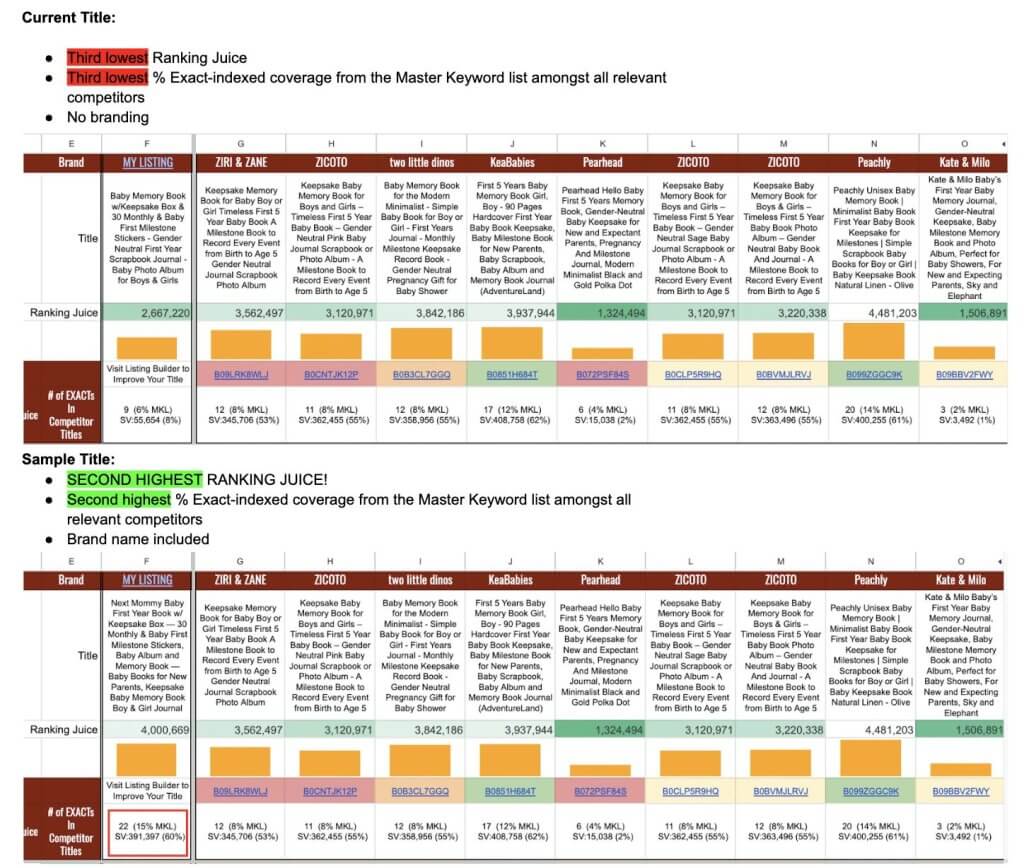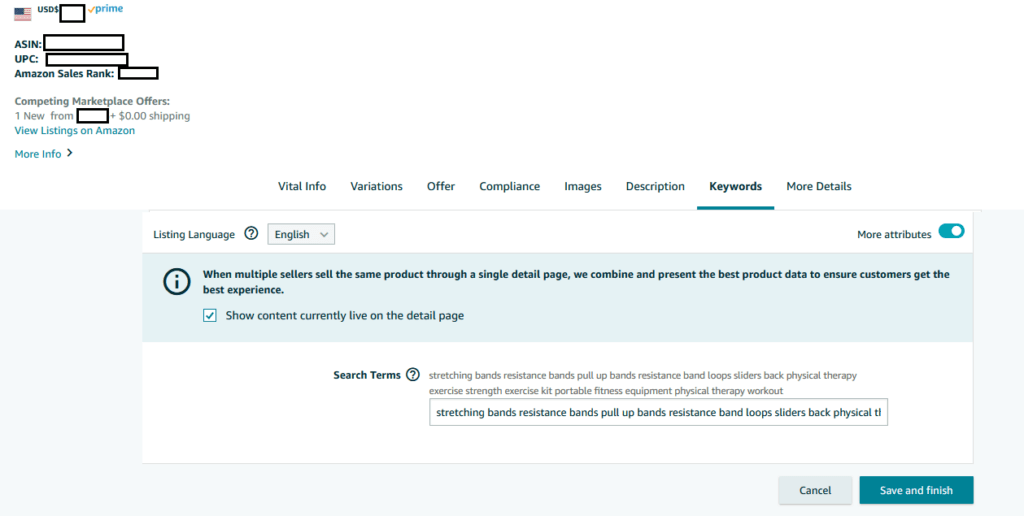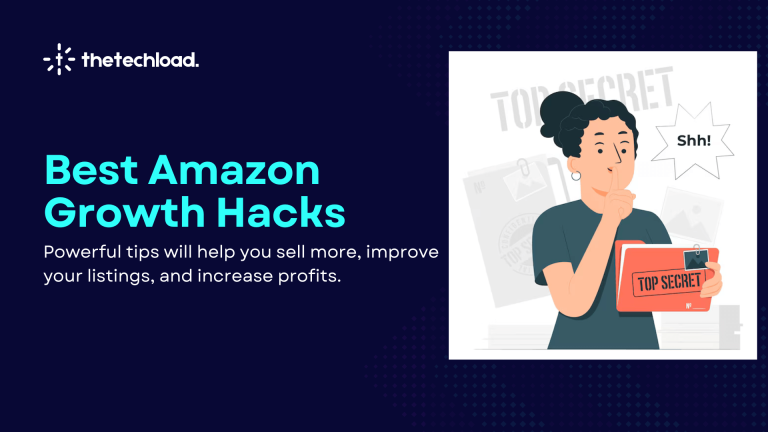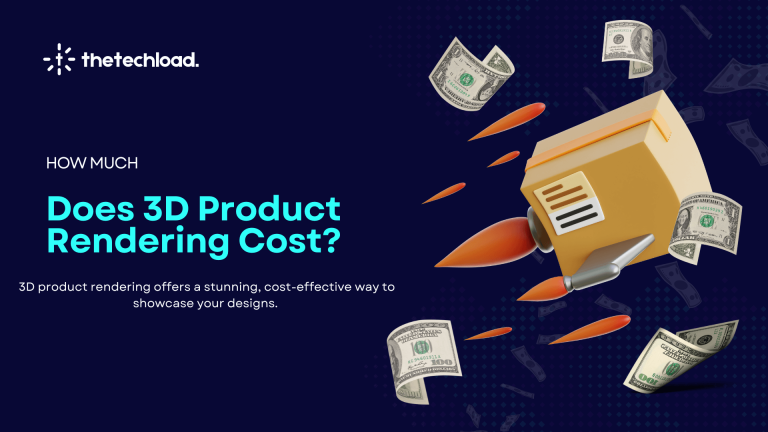Are you struggling to get your product listing on Amazon’s first page, no matter what you try? Understanding how to rank your Amazon product on page one can be incredibly challenging with so many competitors.
The solution lies in learning and applying key strategies to boost your visibility on Amazon. By following the eleven proven techniques outlined below, you can optimize your product listings and significantly improve your chances of ranking on the first page.
Ready to learn how to rank your Amazon product on page one? Read on to discover simple strategies on how to get on the first page of Amazon that can help boost your visibility and sales.
How to Rank Your Amazon Product on Page One – 11 Proven Strategies
Here are comprehensive strategies and best practices to help you rank your Amazon product on page one:
- Research Your Competition and Analyze Their Product Listings
- Include Necessary Keywords in the Product Title, Bullets, Descriptions, and Backend Keywords
- Avoid Keyword Stuffing
- Use High-Quality Product Photos and Videos
- Price Your Products Competitively
- Ship Your Orders Quickly and Provide Outstanding Customer Service
- Ask Your Customers to Review Your Products and Handle Negative Comments Politely
- Use Amazon Ads When Advertising Your Products
- Offer Discounts or Free Shipping
- Sign Up for Amazon FBA
- Optimize Your Listings for Mobile Users
1. Research Your Competition and Analyze Their Product Listings
To rank your Amazon product on page one, it’s essential to conduct a thorough competitive analysis before launching your business. This process helps you identify and evaluate your competitors’ strengths and weaknesses, allowing you to compare your products and services to theirs and find areas for improvement.
Using tools like Helium 10 and Data Dive can make this task much easier. These tools help you identify potential competitors, uncover the keywords they use in their product listings, and analyze their marketing strategies. Additionally, exploring your competitors’ social media platforms and customer reviews can provide valuable insights into their practices and customer satisfaction levels.
By understanding what your competitors are doing well, you can adopt effective strategies and avoid common pitfalls. This comprehensive approach to competitor analysis will help you enhance your own product listings, boost your visibility, and ultimately achieve better results on Amazon.
2. Include Necessary Keywords in the Product Title, Bullets, Descriptions, and Backend Keywords
To successfully rank your Amazon product on page one, integrating the right keywords throughout your product listing is essential. Amazon’s A10 algorithm processes extensive data and evaluates several factors, including the keywords used in your product title, bullet points, descriptions, and backend fields.
Here’s how to optimize each area effectively:
1. Product Title:
The title is one of the most important areas for keyword placement. Include primary keywords that best describe your product, focusing on terms that potential buyers are likely to search for. Ensure the title is clear, descriptive, and compelling, making it easy for customers to understand what you’re offering.

A few quick changes to the Title using Data Dive and:
— The listing’s ranking juice went from 2.6m to 4.0m (third-lowest to second-highest in top ten)
— MKL keyword coverage went from 6% to 15% (third-lowest in top ten to highest)
— MKL Search Volume coverage went from 55,000 to 391,000
— 7 new keywords above 800 SV were covered in Exact form, with 5 of them having a Title Density of two or less.
And the new Title includes the brand name too, better customer recall.
2. Bullet Points:
Use bullet points to highlight key features and benefits of your product. Include secondary keywords naturally within these points to provide more context and detail. This section should emphasize the most important aspects of your product, helping it stand out in search results.
3. Product Descriptions:
Your product description allows for more detailed information. Integrate relevant keywords throughout the description to enhance its visibility. Aim to create a compelling narrative that explains the product’s benefits, uses, and unique selling points, while naturally incorporating keywords.
4. Backend Keywords:
Amazon allows you to add backend keywords that are not visible to shoppers but are used by the algorithm to index your product. Make sure to include variations of your primary and secondary keywords here, as well as any related terms that shoppers might use. This helps ensure your product is indexed for a broader range of search queries.
By strategically placing keywords in these key areas, you can improve your product’s search ranking and increase its chances of appearing on page one of Amazon search results. Remember, the goal is to balance keyword optimization with readability, ensuring your listing is both search-friendly and appealing to potential buyers.

3. Avoid Keyword Stuffing
When optimizing your Amazon listing to rank your Amazon product on page one, it’s important not to overuse keywords. Although it might seem like adding as many high-ranking keywords as possible will boost your visibility, this can lead to issues. Amazon’s algorithm can detect when keywords are excessively stuffed into your listing, which can actually hurt your ranking and lower your visibility.
Instead, use keywords naturally within your product title, bullet points, and description. This keeps your listing clear and appealing to potential buyers. Excessive keyword use can hurt your ranking and sales, so aim for a balanced and readable approach.
If you’re unsure how to optimize your listing effectively, consider consulting an SEO expert for professional advice.
4. Use High-Quality Product Photos and Videos
To effectively rank your Amazon product on page one, high-quality photos and videos are crucial. Beyond just keywords, Amazon’s algorithm evaluates the visual elements of your listing. Following Amazon’s specific guidelines for image file size, background color, and other criteria is essential as these factors can impact your ranking.
Investing in professional photography and video production can significantly enhance your listing. Clear, well-lit photos taken from multiple angles provide potential buyers with a detailed view of your product, while lifestyle images show the product in real-life scenarios, adding context and appeal.
Videos can further boost engagement by demonstrating how the product works and highlighting its benefits. If you qualify for Amazon’s A+ content, take advantage of this by adding high-quality videos that captivate and inform potential customers.
High-quality visuals not only adhere to Amazon’s guidelines but also build trust and encourage purchases. Hiring a professional to handle your photos and videos ensures that your product stands out, attracts more attention, and ultimately helps you rank higher on Amazon.
5. Price Your Products Competitively
To rank your Amazon product on page one, pricing your products competitively is essential. Amazon’s algorithm considers pricing as a significant factor when determining product ranking.
Here’s how to optimize your pricing strategy:
1. Market Research:
Conduct thorough research to understand the pricing landscape of similar products. Identify the price range of your competitors and find a competitive yet profitable price point for your product.
2. Dynamic Pricing Tools:
Utilize dynamic pricing tools that automatically adjust your prices based on market trends, competitor pricing, and demand. These tools help you stay competitive without constantly monitoring prices manually.
3. Promotions and Discounts:
Offering promotions and discounts can attract more customers and boost sales. Temporary price reductions, coupons, and bundle deals can make your product more appealing compared to others.
4. Value Perception:
Ensure your product pricing reflects its value. High-quality images, detailed descriptions, and positive reviews can justify a higher price point and build customer trust, ultimately improving your Amazon product ranking.
5. Monitor and Adjust:
Regularly monitor your product’s performance and adjust prices as needed. Stay flexible and responsive to changes in the market and competitor actions.
By pricing your products competitively, you can improve your chances of achieving a higher Amazon ranking. This strategy helps attract more buyers, increase sales, and enhance your product’s visibility.
6. Ship Your Orders Quickly and Provide Outstanding Customer Service
To rank your Amazon product on page one, prioritize fast shipping and exceptional customer service. Fast shipping attracts buyers, especially Amazon Prime users. Use Fulfillment by Amazon (FBA) or reliable third-party logistics to ensure quick delivery. For wholesale sellers, consider companies that offer Amazon wholesale account services to handle packing, shipping, and marketing.
Responsive customer service is crucial. Address inquiries promptly and resolve issues efficiently to gain positive reviews and customer loyalty. Ensure a smooth return process to boost customer trust.
Monitor performance metrics like Order Defect Rate (ODR) and Late Shipment Rate (LSR) to stay within Amazon’s guidelines. By focusing on these areas, you can improve your product’s ranking and attract more buyers.
7. Ask Your Customers to Review Your Products and Handle Negative Comments Politely
To rank your Amazon product on page one, focus on getting positive reviews and handling negative comments well. Encourage customers to leave reviews by following up after their purchase and providing excellent service. Respond to negative feedback promptly and politely, offering solutions where possible.
Use reviews to improve your products and services, and consider offering incentives for feedback, ensuring compliance with Amazon’s policies. By managing reviews effectively, you boost your product’s reputation and increase your chances of higher rankings on Amazon.
8. Use Amazon Ads When Advertising Your Products
Advertising directly on Amazon can effectively boost your product’s visibility. Amazon provides various ad options, including Sponsored Products, Sponsored Brands, and Stores. Sponsored Products are available to all sellers, while Sponsored Brands and Stores are accessible to those in the Amazon Brand Registry.
These advertising options can help showcase your products to a larger audience, targeting shoppers actively browsing Amazon. To maximize their impact, allocate a budget that ensures your ads stay visible and engaging. Utilizing Amazon’s advertising tools can significantly increase your product’s exposure and help rank your Amazon product on page one, attracting more potential buyers.
9. Offer Discounts or Free Shipping
To enhance your Amazon product’s ranking and attract more buyers, consider offering discounts or free shipping. These promotions can make your listing more appealing and competitive.
Discounts, such as limited-time offers or coupon codes, can entice shoppers to make a purchase by highlighting savings. Free shipping, especially when combined with Amazon Prime or through Fulfillment by Amazon (FBA), can also boost your product’s attractiveness and increase its chances of ranking higher.
Effective promotions not only draw in more customers but also encourage faster sales and higher conversion rates, contributing to better visibility and helping to rank your Amazon product on page one of Amazon’s search results.
10. Sign Up for Amazon FBA
Enrolling in Amazon’s Fulfillment by Amazon (FBA) program can significantly enhance your product’s ranking and visibility. FBA allows Amazon to handle storage, packaging, and shipping of your products, ensuring fast and reliable delivery to customers.
By using FBA, your products become eligible for Amazon Prime and other Amazon services, which can increase their attractiveness to buyers. Additionally, FBA’s efficient logistics and customer service can lead to better reviews and fewer issues, further boosting your product’s ranking.
Signing up for FBA also helps you meet Amazon’s high standards for shipping and service, which can positively impact your product’s placement on the search results page and drive more sales.
11. Optimize Your Listings for Mobile Users:
To rank your Amazon product on page one, ensure your listings are optimized for mobile users. As more shoppers use mobile devices, a mobile-friendly experience becomes essential.
By enhancing the mobile view of your product titles, images, and descriptions, you can improve user engagement and increase conversion rates. A well-optimized mobile listing not only provides a better shopping experience but also helps boost your product’s visibility and ranking on Amazon.
Conclusion
To successfully rank your Amazon product on page one, you need to adopt a well-rounded approach. Focus on optimizing your keywords, using high-quality images and videos, setting competitive prices, and ensuring fast, reliable shipping. Additionally, make use of Amazon Ads to boost visibility, offer discounts or free shipping to attract buyers, and consider signing up for Amazon FBA to leverage Amazon’s fulfillment network.
Mastering how to rank your Amazon product on page one involves more than just one-time adjustments. Regularly update your listings, analyze competitors, and adapt to changes in market trends to sustain and improve your ranking.
For more strategies and expert advice on boosting your Amazon sales, visit TheTechLoad. We provide the latest tips and tools to help you excel in the competitive world of e-commerce.
FAQs
Positive reviews significantly boost your ranking.
Yes, keywords in titles improve search visibility.
Sponsored ads can increase visibility and sales.
Regular updates with relevant keywords improve ranking.
Competitive pricing helps improve your product’s rank.






2 Responses